Cronin, M.F., and T. Tozuka (2016): Steady state ocean response to wind forcing in extratropical frontal regions. Scientific Reports, 6, 28842, doi:10.1038/srep28842.
Wind forcing is fundamental to the ocean circulation. According to the classic “Ekman” theory developed in the early twentieth century, wind-induced steady flow spirals to the right of the wind stress in the Northern Hemisphere and to the left in the Southern Hemisphere, resulting in a net wind-forced “Ekman” transport that is 90 degrees to the right of the wind stress in the Northern Hemisphere and to the left in the Southern Hemisphere. This theory, however, assumes that the near-surface ocean is uniform in density (i.e., has no fronts). In frontal regions the surface “geostrophic” currents have a vertical shear aligned with the density front and this oceanic “thermal wind” shear can balance a portion of the surface wind stress.
In this paper we show that in frontal regions, the classic Ekman response is altered. Surface ocean currents respond to the effective wind stress—the portion of the wind stress that is out of balance with the ocean’s surface geostrophic shear. Using data from the high-resolution Japanese Ocean general circulation model For the Earth Simulator (OFES), we show that these frontal effects cannot be ignored in the Tropics or in strong frontal regions in the extratropics, such as found in coastal regions and in western boundary currents of all basins. Furthermore, frontal effects dominate the classic Ekman response in regions of both hemispheres where trade winds change to westerlies. These frontal effects on the steady-state surface current response to wind forcing have important implications for vertical motion and for global heat budgets.
For more information or to read this article, please visit the Scientific Reports article page here.



